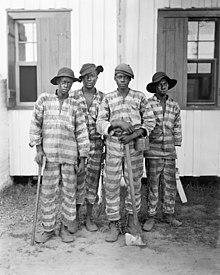
Back Convict Leasing German Ενοικίαση καταδίκων Greek Convict leasing French 囚人貸出制度 Japanese Аренда заключённых Russian Convict lease SIMPLE
This article has multiple issues. Please help improve it or discuss these issues on the talk page. (Learn how and when to remove these template messages)
|

| Part of a series on the |
| Nadir of American race relations |
|---|
 |
Convict leasing was a system of forced penal labor that was practiced historically in the Southern United States, the laborers being mainly African-American men; it was ended during the 20th century. It provided prisoner labor to private parties, such as plantation owners and corporations (e.g. Tennessee Coal and Iron Company and Chattahoochee Brick Company).
The state of Louisiana leased out convicts as early as 1844.[1] The system expanded throughout most of the South with the emancipation of enslaved people at the end of the American Civil War in 1865.[2] The practice peaked about 1880, was formally outlawed by the last state (Alabama) in 1928, and persisted in various forms until it was abolished by President Franklin D. Roosevelt via Francis Biddle's "Circular 3591" of December 12, 1941.
The system was highly lucrative for both the lessees and state governments.[2] For example, in 1898, 73% of Alabama's annual state revenue came from convict leasing.[3] Corruption, lack of accountability, and violence resulted in "one of the harshest and most exploitative labor systems known in American history".[4] African Americans, mostly adult males, due to "vigorous and selective enforcement of laws and discriminatory sentencing", comprised the vast majority—though not all—of the convicts leased.[5]
While states of the Northern United States sometimes contracted for prison labor, the historian Alex Lichtenstein notes that "only in the South did the state entirely give up its control to the contractor; and only in the South did the physical "penitentiary" become virtually synonymous with the various private enterprises in which convicts labored".[6]
The writer Douglas A. Blackmon described the system:
It was a form of bondage distinctly different from that of the antebellum South in that for most men, and the relatively few women drawn in, this slavery did not last a lifetime and did not automatically extend from one generation to the next. But it was nonetheless slavery – a system in which armies of free men, guilty of no crimes and entitled by law to freedom, were compelled to labor without compensation, were repeatedly bought and sold, and were forced to do the bidding of white masters through the regular application of extraordinary physical coercion.[7]
- ^ Punishment in America: A Reference Handbook, by Cyndi Banks, page 58
- ^ a b Schwarz, Susanne (2023). ""The Spawn of Slavery"? Race, State Capacity, and the Development of Carceral Institutions in the Postbellum South". Studies in American Political Development. 37 (2): 181–198. doi:10.1017/S0898588X22000281. ISSN 0898-588X.
- ^ Robert Perkinson (2010). Texas Tough: The Rise of America's Prison Empire. Henry Holt and Company. p. 105. ISBN 978-1-429-95277-4.
- ^ Mancini, Matthew J. (1996). One Dies, Get Another: Convict Leasing in the American South, 1866-1928. Univ of South Carolina Press. pp. 1–2. ISBN 978-1-57003-083-3.
- ^ Litwack, Leon F. Trouble in Mind: Black Southerners in the Age of Jim Crow, (1998) ISBN 0-394-52778-X, p. 271
- ^ Alex Lichtenstein, Twice the Work of Free Labor: The Political Economy of Convict Labor in the New South, Verso Press, 1996, p. 3
- ^ Blackmon, Douglas A. Slavery by Another Name: The Re-Enslavement of Black Americans from the Civil War to World War II, (2008) ISBN 978-0-385-50625-0, p. 4
© MMXXIII Rich X Search. We shall prevail. All rights reserved. Rich X Search